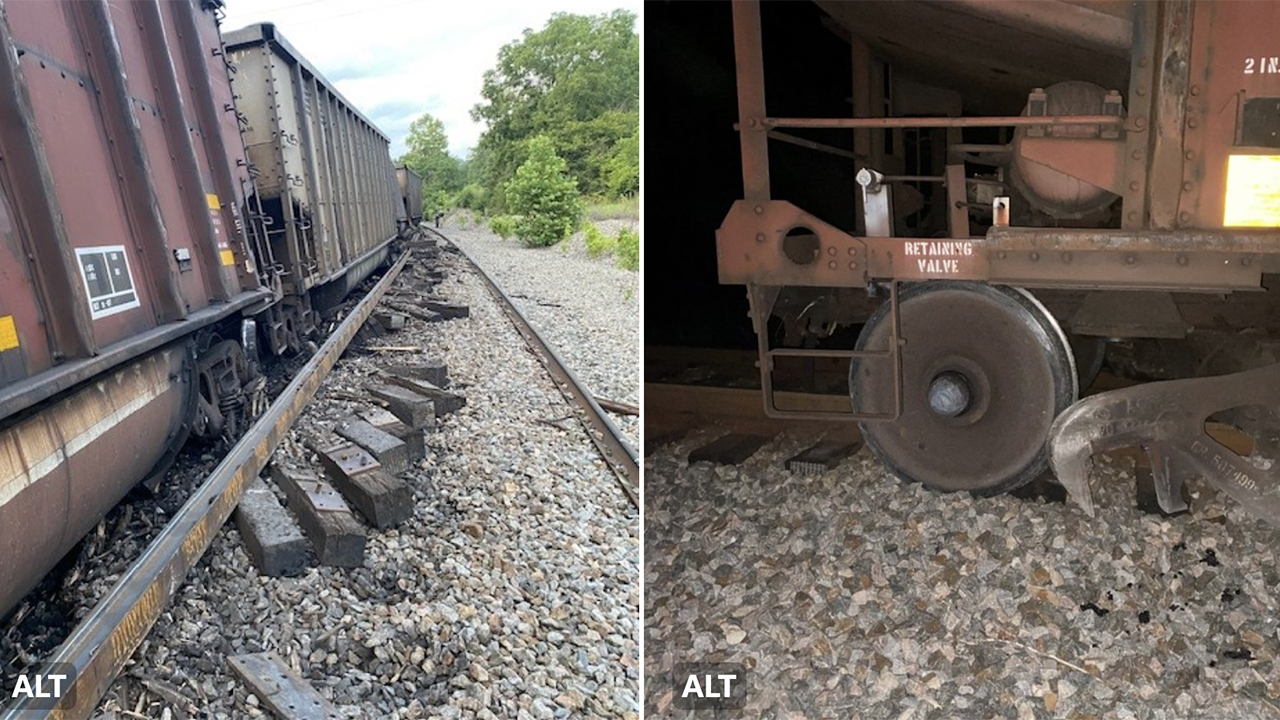
NTSB Issues Preliminary Report on NS Coal Train Derailment
Written by Marybeth Luczak, Executive Editor
NTSB-provided photographs from the July 6, 2023, Norfolk Southern derailment in Virginia: Derailed gondola cars (left) and a wheelset with a burned-off bearing (right) from unit coal train 814V404. (Sources: NS, left; Federal Railroad Administration, right.)
The National Transportation Safety Board (NTSB) has released its preliminary report for the investigation of Norfolk Southern’s (NS) July 6, 2023, coal train derailment near Elliston, Va. The agency said future activity will focus on the wheelset and reconditioned bearings of the 71st railcar of the 105-car train; NS’s use of hot bearing detectors (HBD); and NS’s operating rules for defective equipment detectors.
At about 7:42 p.m. local time, eastbound NS unit coal train 814V404 derailed 19 loaded gondola cars on a single main line track of the NS New River Division’s Whitethorne District at milepost 263.7, according to the report, which NTSB said contains information that is “preliminary and subject to change.” This section of track is owned by the Virginia Passenger Rail Authority and operated and maintained by NS. Visibility conditions at the time of the derailment, NTSB said, were daylight and clear, and the temperature was 82°F with no precipitation.
According to the report, the derailed equipment remained upright and did not separate from other railcars in the train; there were no injuries, fatalities, fires or release of coal. NS estimated equipment and track infrastructure damages to be $288,360, NTSB said.
The 5,562-foot-long train included three head-end locomotives and was operated by one engineer and one conductor. It was traveling at about 25 mph at the time of the derailment, less than the maximum authorized timetable speed of 40 mph, according to the report.
NTSB said train movements in the area of the derailment are authorized by a centralized traffic control system and coordinated by the New River Division train dispatcher located in Atlanta, Ga. Additionally, the rail network in the derailment area is equipped with wayside HBDs “to assess the temperature of wheel bearings while trains are en route,” the report said. “HBDs detect overheated bearings, provide real-time audible alarm messages to train crews, and alert railroad technicians monitoring the advanced train control (ATC) system. A critical alarm is sent when the HBD has detected bearings above 170°F; if this alarm is received, the crew must immediately bring the train to a controlled stop for inspection.”
According to the report, at about 5:29 p.m., “an HBD at milepost 276.3 transmitted a critical alarm message for an axle on the 71st railcar of train 814V404. After the crew stopped the train, the conductor inspected the railcars and told the ATC desk that the axle’s temperature indicator stick had melted slightly, indicating a measurement of 169°F or higher, and that some grease was coming from the back of one of the axle bearings. The ATC desk advised the crew to confer with the train dispatcher, who directed them to set out the railcar for inspection. The dispatcher gave the crew permission to move the train about 13 miles east to the Riverside siding to set out the railcar; as the crew was moving the train to this location, the derailment occurred.”
NS, on July 7, issued an operations bulletin “providing clarification of the requirements for responding to hot bearing and dragging equipment alarms,” according to the report. “The bulletin states that upon receiving a critical hot bearing alarm, the crew must immediately stop the train for inspection. If the overheated condition is confirmed, the crew must inform the ATC desk and seek guidance on moving to the next available set out location. Any authorized movement must not exceed 10 mph, and the defective railcar must be reinspected at least every three miles until set out. The bulletin further states that a visual inspection of the indicated bearing and its associated components must be performed. If this inspection reveals exceptions (for example, leaking grease or visible damage), the ATC desk must be notified, and NS mechanical department personnel must perform an inspection before the railcar is moved.”
The NTSB said its investigators on scene “recovered burned-off bearing components, wheels, and axles from the 71st railcar.” The agency also reviewed information from data logs, the lead locomotive event recorder, and forward- and inward-facing image recorders; examined and tested railroad equipment; and completed interviews.
The investigation is ongoing, and the NTSB said future activity will focus on the 71st railcar’s wheelset and reconditioned bearings; NS’s use of HBDs; and NS’s operating rules for defective equipment detectors.
Parties to the investigation include the Federal Railroad Administration; Virginia Passenger Rail Authority; NS; International Association of Sheet Metal, Air, Rail and Transportation Workers-Transportation Division; Brotherhood of Railroad Signalmen; and Brotherhood of Locomotive Engineers and Trainmen.



